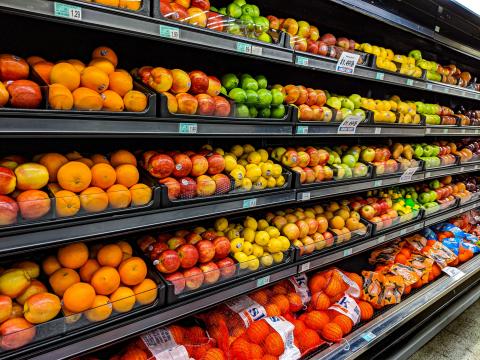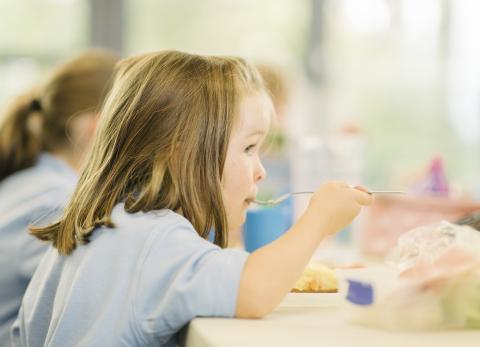Kids Food Guarantee Update: Packed Lunches - May 2024
To be fuelled for the school day and be set up to do their best in school, children need to be well fed. To achieve this, all school children should have access to a hot, nutritious meal from their school canteen each day to keep them full and nourish their minds and bodies.
However, in England, not all children get this and 900,000 children living in poverty across the country do not qualify for the Government’s Free School Meals scheme due to the stringent criteria that Government set for children they deem to be deserving of receiving them.
Despite being above the income threshold, many of these children missing out on Free School Meals are not able to afford lunch from the school canteen, and instead are reliant on packed lunches or unable to afford any food at all.
Research shows that less than 2% of packed lunches meet the School Food Standards and so offer a far less nutritious option than school meals. We know that many parents want to send their children off to school with a healthy, tasty, packed lunch but often this is not the cheapest or most convenient option.
We are calling on Government to extend Free School Meals so that the most deprived children are not priced out of a hot, nutritious lunch with their peers; but in the meantime, we’re calling on supermarkets to ensure they are selling healthy, convenient packed lunch items at an affordable price.
This latest update in our series of ongoing monitoring of the extent to which supermarkets are supporting low-income families through the cost-of-living crisis unfortunately shows that not enough action is being taken.
Updated Food Foundation analysis shows the price of a healthy packed lunch has increased across four out of five major retailers
To see if there has been any action by retailers, we have reassessed the same products we analysed in September and November 2023. (September 2023 and November 2023 reports on lunchboxes).
The items in the healthy packed lunch are:
The weekly cost varied across the retailers from £8.56 to £11.72. In comparison, a Free School Meal allowance is approximately £12.50 per week. Therefore, for children paying for a school lunch, a healthy packed lunch is not always significantly cheaper than buying lunch from the school canteen depending on which retailer and what the school canteen offers.
Since we last assessed this in November 2023, increases in price for the packed lunch have been seen across four out of the five retailers, with the price from the fifth retailer plateauing.
Morrisons’ items remain substantially higher cost than the other four retailers, costing 37% more than Tesco which has consistently been the most economical place to purchase a healthy packed lunch.
The biggest increase has been in Sainsbury’s, where customers would have to spend 9% more than they did at the start of the academic year for the same packed lunch.
To put this cost in context, the average weekly expenditure on food and non-alcoholic drink per person for the poorest 10th of UK households is £25 per week.
For families unable to stretch their budgets to cover the higher costs due to limited financial means, the only options are to cut back on the amount of food they are giving their children - potentially resulting in children going hungry and leaving them struggling to concentrate in class - or switching to cheaper alternatives which are often less healthy.
New Food Foundation analysis shows less healthy alternatives for packed lunches are substantially cheaper than the healthy packed lunch
To further understand whether switching to cheaper options due to limited resources could result in children eating a less healthy packed lunch, we analysed the cost of a packed lunch consisting of less healthy alternative products and compared it with the cost of our healthy packed lunch.
The alternative items in the unhealthy packed lunch are:

The unhealthy lunch generally contains more sugar, and less fibre and micronutrients than the healthy lunch. For example, the unhealthy lunch contains white bread instead of wholemeal bread, with white bread more highly processed and containing less fibre than wholemeal.
Instead of cheese in the sandwich, there is chocolate spread, which is approximately 50% sugar; and instead of a plain yogurt, there is a flavoured yogurt which contains approximately 2.5 times as much sugar. There are no fruit and veg in the less healthy lunch compared to four portions in the healthy lunch.
Our analysis shows that across all five retailers, the unhealthy packed lunch was substantially cheaper.
The smallest discrepancy was at Tesco where the healthy lunch was just 9% more expensive, compared to Aldi which had the biggest discrepancy, with the healthy lunch is 77% more expensive than the less healthy packed lunch.
This means when shopping at Aldi, it is possible to buy nearly nine days’ worth of unhealthy packed lunches for the same price as five days of healthy packed lunches.
Morrisons shows a similar picture: eight days’ worth of unhealthy packed lunches costing the same as five days of healthy packed lunches.
Therefore, for families on tight budgets, the sensible economic choice is not the healthy option which could detrimentally impact on children’s long-term health and exacerbate diet-related health inequalities.
What should retailers do?
Overall, the findings show that there has been a deterioration in the affordability of the reasonably healthy packed lunch despite a slowing in food price inflation since last November. We also find that unhealthy options are much cheaper than healthier lunch box items.
While we hope to see Government extend Free School Meals so that the most deprived children are not priced out of a hot, nutritious lunch with their peers, in the meantime supermarkets need to ensure they are selling a healthy, convenient packed lunch at an affordable price.
As part of our Kid’s Food Guarantee we are calling on retailers to offer packed lunch items that are compliant with School Food Standards and make up five lunches that can be bought at affordable price point, for example through a multibuy deal.
Our polling found that nearly two thirds (64%) of low income families (C2DE) would find it helpful for them in feeding their children well if retailers offered a lunchbox meal deal so that they can easily buy items to make up a week of healthy lunchboxes for their children.
No retailer currently has such a meal deal, but this would go a long way to helping time-poor families on tight budgets to provide their children with a healthy packed lunch.
Items that could be included in any such deal include: wholegrain or 50:50 wheat products such as bread, rolls and wraps; snackable fruit and veg such as apples and carrots; sandwich fillings such as spreads and cheese; and single portion unsweetened yogurt pots.
Method details
- These food items have been taken as indicative items that can form part of a healthy packed lunch and are not an exhaustive list. We have chosen these items to gain a balance between a nutritious lunch and one which children may realistically eat as it’s important for low income families to provide food that their children will not reject so it doesn’t go to waste. Portion sizes would need to vary depending on the child’s age but *this lunch is likely suitable for an older child, or a younger child including snacks eaten over the course of the school day.
- The food items in the less healthy lunch have been chosen as products which might be reasonably substituted based on type and volume of food. These are again foods which children might realistically consume as part of a packed lunch.
- The closest comparable product between retailers was selected.
- We have looked at the cost of the lunch across the five retailers with the biggest share of the market.
- Products were available online from retailers websites on 2nd May.
- Multibuys were not included, single promotions were included.
- The price given is for the proportion of the product needed for the portion sizes given, not the full cost of the item.
- The full list of products analysed from each retailer is available here.





